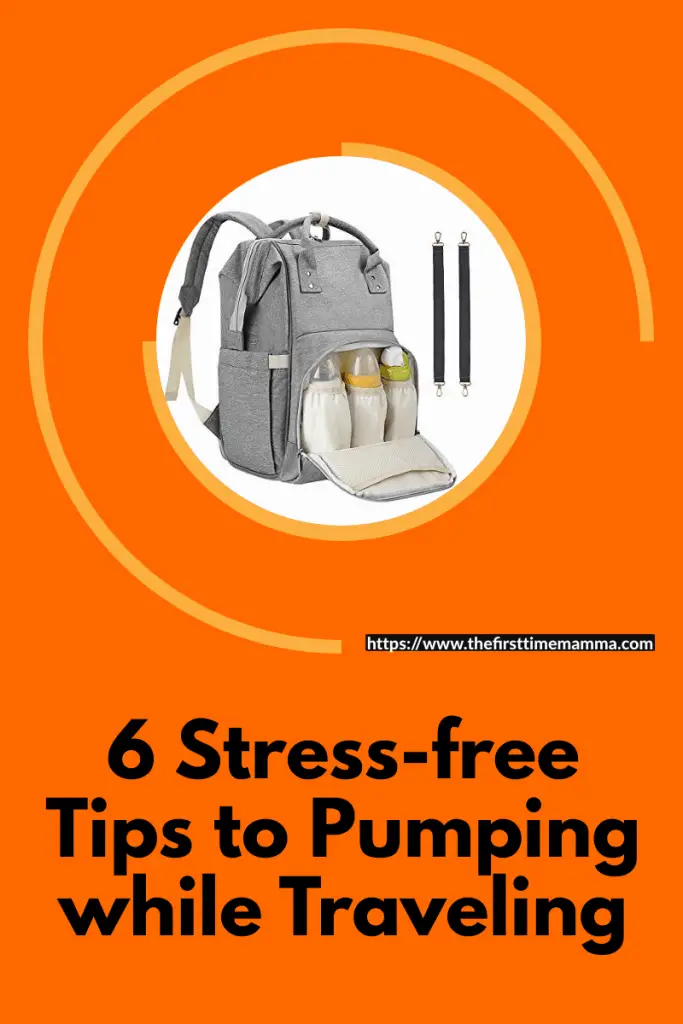Breastfeeding is a convenient method of feeding your baby. It doesn’t require any additional prep work like washing and sterilizing. But if you’re a first-time breastfeeding mom who has to travel often due to work-related stuff or other issues, then it can be a hassle for you. Travel regulations, milk storage, and packing all of your pump parts can become stressful and overwhelming for you. So, to help all you travel and pumping mamas out there, here’s how to pump while traveling tips you need to follow to make this experience a little less stressful and daunting.
Hey! By the way… any links on this page that lead to products on Amazon are affiliate links and I earn a commission if you make a purchase. Thanks in advance – I really appreciate it! .
How to pump while traveling tips
1) Find the pump that works best for you
As a traveling mom, you need to find your best ally i.e. a good quality breast pump. These are the options available for you to choose from.
- Hospital-grade pumps: These are mainly seen in hospitals or employer-sponsored nursing rooms. Some hospitals may send you home with this in case of complications after delivery. They are sturdy but are very bulky and thus require a lot of space. So, these are the least travel friendly of the bunch.
- Electric Breast Pump: Also known as a working breastfeeding mom’s best friend. Many of these come with plug-in options, but few have battery options or accessories like a car adapter for convenient use while traveling. If you can afford it, then buying a double electric breast pump will make your life as a pumping mother a lot easier.
- Manual Pump: Having a manual pump in case of emergency can make your life easier. It’s super cheap and doesn’t require much space. Though it isn’t much effective in emptying the breast, but having a backup is very reassuring.
2) Things to take with you
Many of the things you must pack for your pumping sessions will be quite the same, regardless of the pump you end up choosing. Here’s a list of things your pumping bag should have.
- A breast pump
- Pumping accessories like flanges, tubing, power cord, car adapter, etc.
- Milk collections, bags, and bottles.
- Batteries and extra batteries as a backup
- Cooler
- Ice packs
- Nursing cover
- Sanitizing wipes for the pump
- Hands-free pumping bra
- A pen to note the date and time on which the milk was expressed.
3) How to get your milk through security
In case you are traveling by air, it will get tricky. With all the restrictions on carry-on items and the limited amount of liquids allowed on the plane, you might be worried about what’s right and legal. According to the Transportation Security Administration (TSA), you can take pumped milk with you through security even when your baby isn’t with you.
Also, it’s not subject to limitations that other liquids are subjected to. It is categorized into the medicine category so those rules don’t apply to it. During the security check at the airport, inform the security agent that you’re carrying breast milk with you. Remove it from the carry-on bag and place it in a separate bin from the rest of your items during the security check. No adverse effects of x-rays had been detected in expressed milk going through security, so you don’t have to worry about that.
4) Pumping while in the plane or at the airport
Pumping on the road or in the air can be quite a hassle as you struggle with finding a proper place to pump discreetly without the feeling of being stared at. These days many airports have nursing rooms for mothers; complete with changing tables and plug outlets. In case your airport is small and doesn’t have any designated room for nursing, then you can try pumping in a restroom. If you’re concerned about germs getting on the pump, then use those breast pump sanitizing wipes and a hand sanitizer. In case you have to pump in the plane, then try to select a seat that will offer you some privacy while pumping, like the window seat. You can also slide those wearable cups under your nursing cover and shirt discreetly, without catching anyone’s eye.
5) Keeping milk fresh
After you’ve expressed the milk, the next challenge is to not let it get spoiled. The shelf life of breast milk is relatively short, i.e. 4 days in a refrigerator. So, keeping it at cold temperatures to prevent it from getting spoiled is very important. You can keep your milk fresh by following these simple tips.
- Use a cooler with ice packs: Milk will stay fresh in a cooler with ice packs for 24 hours as long as the internal temperature is maintained at 4 degrees Celsius. This is a good option in case you don’t have access to a fridge or are traveling by air.
- Using the hotel’s fridge: Call your hotel ahead of time and ask them to lend you their fridge for some time so you can keep your breast milk in it to prevent it from getting spoiled (just write your name on the milk bags along with the date so it doesn’t get misplaced). Some hotel rooms also come with their little fridges, so call before booking the hotel to know if that option is available in your hotel.
- Car coolers: If you’re traveling by car then you can easily plug in an electric cooler into your car’s outlet.
6) Bringing milk home
If you want to ship your milk home or want a hassle-free trip without having to take those milk bags with you, then you can try shipping your milk through UPS or FedEx. Put the milk into a cooler with ice packs and ship it overnight to your home. Let your family know that you’ve shipped the milk and how should they go about freezing it.
So, there you have it, mommies – how to pump while traveling. It doesn’t matter which means you’re traveling. As long as you keep the right equipment with you and know the perfect strategy to get your precious liquid gold home safely, you’ll have a smooth and hassle-free journey without any stress of pumping and shipping your milk for your little one.
Learn how to pump like a pro and make lots of Milk.

